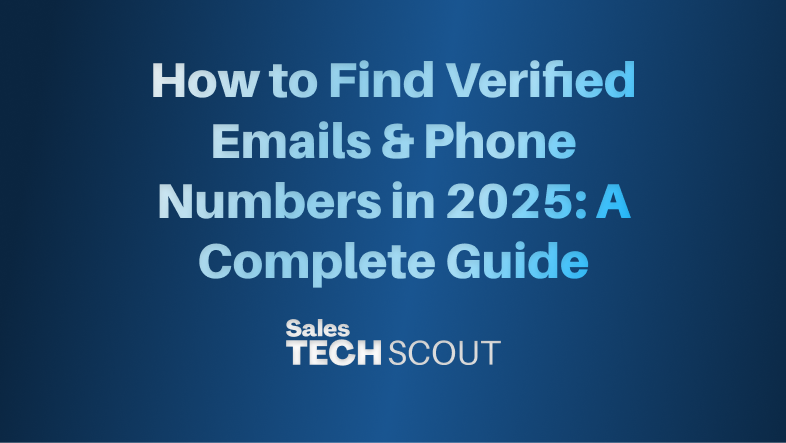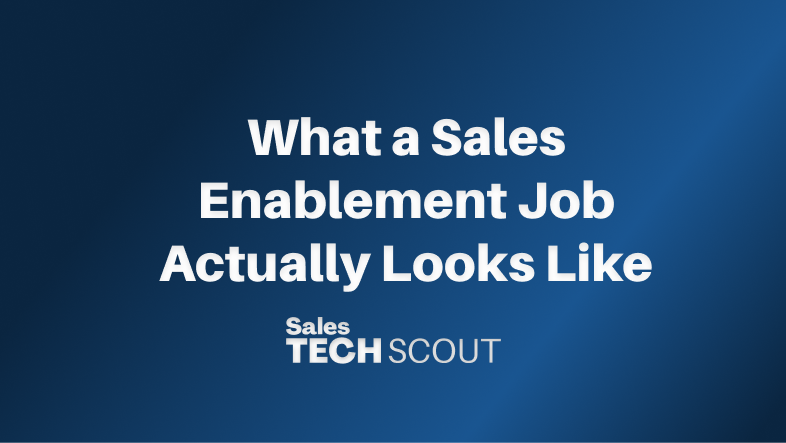How to Find Verified Emails & Phone Numbers in 2025: A Complete Guide


Introduction
In today's competitive B2B landscape, the quality of your contact data directly impacts your sales success. With inbox algorithms becoming increasingly sophisticated and privacy regulations tightening, the days of mass emailing unverified lists are over.
Modern sales teams need precise, verified contact information to maintain deliverability rates, build trust, and drive meaningful conversations.

This comprehensive guide will walk you through the most effective methods for finding and verifying email addresses and phone numbers in 2025, with a focus on sustainable, compliant approaches that protect your sender reputation while maximizing your outreach potential.
Why Contact Data Accuracy Is Essential in Sales Workflows
Poor data quality costs businesses an average of $12.9 million annually, according to recent studies. For sales teams, inaccurate contact information creates a cascade of problems that extend far beyond bounced emails.

Email deliverability suffers dramatically with bad data. Internet Service Providers (ISPs) track bounce rates, spam complaints, and engagement metrics to determine sender reputation. A single campaign with high bounce rates can land your domain in spam folders for months.
Sales productivity plummets when reps waste time on dead leads. Research shows that sales professionals spend 21% of their day writing emails and 17% prospecting and researching leads. When contact data is inaccurate, this time investment yields zero return.
Customer trust erodes with sloppy outreach. Nothing screams "mass email blast" like addressing prospects by the wrong name or contacting them at outdated companies. Personalized, accurate outreach signals professionalism and attention to detail.
Compliance risks multiply with unverified data. GDPR, CAN-SPAM, and similar regulations require explicit consent for marketing communications. Using outdated or purchased lists without proper verification creates legal liability.
Manual vs Automated Lead Sourcing: Pros and Cons
Sales teams typically choose between two approaches for building contact databases: manual research or automated tools.
Each method has distinct advantages and limitations that impact scalability, accuracy, and resource allocation.

Manual Lead Sourcing
Pros:
- Complete control over data selection and quality
- Deep research enables highly personalized outreach
- No tool costs or subscription fees
- Better understanding of prospect context and pain points
Cons:
- Extremely time-intensive (5-10 minutes per contact)
- Limited scalability for large campaigns
- Higher risk of human error in data entry
- Difficult to verify email deliverability without additional tools
Automated Lead Sourcing
Pros:
- Rapid data collection (hundreds of contacts per hour)
- Built-in verification and enrichment capabilities
- Standardized data formats reduce errors
- Real-time validation prevents outdated information
Cons:
- Subscription costs can be significant for high-volume users
- Less contextual understanding of individual prospects
- Over-reliance on automation may reduce personalization
- Quality varies significantly between different platforms
Most successful sales teams adopt a hybrid approach, using automation for initial data collection and manual research for high-value prospects or complex deals.
Step-by-Step Process Using Enrow: Upload, Verify, and Enrich
Enrow represents the latest generation of contact intelligence platforms, combining multiple data sources with AI-powered verification to deliver accurate, compliant contact information.
Here's how to leverage the platform for maximum effectiveness.
Step 1: Upload Your Lead List
Begin by preparing your existing prospect data in a CSV format. Include any available information such as:
- First and last names
- Company names
- Job titles
- Industry classifications
- Geographic locations
Log into your Enrow dashboard and navigate to the "Upload" section. The platform accepts CSV, Excel, and direct CRM integrations. For best results, ensure your column headers match Enrow's field requirements.


Step 2: Configure Verification Settings
Before processing your list, configure verification parameters based on your outreach strategy:
Email Verification Levels:
- Deliverable: High-confidence working addresses
- Risky: Addresses that may work but carry higher bounce risk
- Invalid: Non-working or problematic addresses
Phone Number Validation:
- Mobile vs. landline preferences
- Geographic restrictions
- Do Not Call registry checking
Set your confidence thresholds based on campaign priorities. Conservative settings reduce list size but improve deliverability rates.

Step 3: Execute Data Enrichment
Enrow's enrichment engine searches across multiple databases to complete missing information:
- Professional email addresses following company patterns
- Direct dial phone numbers from business directories
- Updated job titles and company affiliations
- Social media profiles for additional context
The platform typically processes 1,000 contacts in 2-3 minutes, significantly faster than manual research while maintaining accuracy standards.
Step 4: Review and Filter Results
Once processing completes, review the enriched dataset using Enrow's filtering capabilities:
- Sort by confidence scores to prioritize highest-quality contacts
- Filter by verification status to remove risky addresses
- Segment by job level, department, or company size
- Identify and remove potential spam traps or role-based emails
This quality control step prevents deliverability issues and ensures compliance with email marketing regulations.
Exporting and Syncing with Your CRM or Outreach Platform
Modern sales workflows require seamless data integration between lead generation tools and execution platforms. Enrow supports direct integrations with popular CRMs and outreach tools, eliminating manual data transfer and reducing errors.
Direct CRM Integration
Connect Enrow directly to your CRM system to automatically sync verified contacts vi their API:
Supported Platforms:
- Salesforce
- HubSpot
- Pipedrive
- Monday.com
- Custom API integrations
Set up automated sync schedules to keep contact data fresh without manual intervention. Most integrations update records in real-time, ensuring sales reps always access current information.
Outreach Platform Connection
For teams using dedicated outreach tools, thanks to its API, Enrow integrates with:
- Outreach.io
- SalesLoft
- Apollo
- Lemlist
- Mailshake
These integrations enable one-click campaign setup using newly verified contact data, streamlining the transition from research to outreach.
Export Options for Flexibility
When direct integration isn't available, Enrow provides multiple export formats:
- CSV files for universal compatibility
- Excel spreadsheets with advanced formatting
- API endpoints for custom integrations
- Webhook notifications for real-time updates

Compliance: GDPR, Opt-in Best Practices
Contact data collection and usage must comply with increasingly strict privacy regulations worldwide. Understanding these requirements protects your business from legal liability while building trust with prospects.
GDPR Compliance for EU Prospects
The General Data Protection Regulation applies to any business contacting EU residents, regardless of company location:
Lawful Basis Requirements:
- Legitimate interest for B2B prospecting (with clear opt-out mechanisms)
- Explicit consent for marketing communications
- Contractual necessity for existing customer relationships
Data Subject Rights:
- Right to access personal data
- Right to rectification of inaccurate information
- Right to erasure ("right to be forgotten")
- Right to data portability
Maintain detailed records of data collection sources and processing activities to demonstrate compliance during audits.

CAN-SPAM Act Compliance (US)
US-based outreach must follow CAN-SPAM requirements:
- Clear sender identification in email headers
- Truthful subject lines without deceptive content
- Physical address disclosure in email footers
- One-click unsubscribe mechanisms
- Honor unsubscribe requests within 10 business days
Global Best Practices
Beyond legal requirements, follow industry best practices for ethical prospecting:
Permission-Based Marketing:
- Use double opt-in for newsletter subscriptions
- Clearly explain how contact information will be used
- Provide granular preferences for communication types
Transparency in Data Collection:
- Disclose data sources in privacy policies
- Offer clear opt-out mechanisms on first contact
- Respect industry-specific regulations (HIPAA, FINRA, etc.)
Bonus: How to Avoid Fake or Spam-Trap Leads
Sophisticated email verification goes beyond simple syntax checking to identify problematic addresses that could harm your sender reputation. Understanding common spam traps and fake email patterns helps maintain list quality and deliverability rates.
Identifying Spam Trap Addresses
Honeypot Traps: Created specifically to catch spammers, these addresses appear on purchased lists but never belong to real people. They're often formatted as common names at popular domains (john.smith@gmail.com variants).
Recycled Traps: Previously legitimate addresses that ISPs convert to traps after abandonment. These are particularly dangerous because they may initially appear valid.
Typo Traps: Addresses with common misspellings of popular domains (gmial.com, yahooo.com). These catch careless list building practices.
Advanced Verification Techniques
Domain Analysis:
- Check domain age and reputation
- Verify MX records and mail server configuration
- Identify suspicious domain patterns or bulk registrations
Behavioral Signals:
- Monitor engagement patterns across campaigns
- Flag addresses with consistent zero interaction
- Identify unusual geographic or demographic clusters
Real-Time Validation:
- Use API calls to verify addresses at point of collection
- Implement progressive profiling to build data gradually
- Cross-reference against known spam trap databases
Maintaining List Hygiene
Regular Cleaning Schedules:
- Monthly verification for active outreach lists
- Quarterly deep cleaning for dormant segments
- Annual compliance audits and data purging
Engagement-Based Segmentation:
- Separate highly engaged contacts for premium treatment
- Create re-engagement campaigns for inactive subscribers
- Sunset unresponsive contacts after defined periods

Measuring Success and ROI
Effective lead sourcing requires ongoing measurement and optimization. Track key metrics to understand tool performance and campaign effectiveness:
Data Quality Metrics:
- Email deliverability rates by source
- Phone connection rates for outbound calls
- Data decay rates over time
- Cost per verified contact
Campaign Performance:
- Open and response rates by list segment
- Conversion rates from prospect to opportunity
- Revenue attribution by data source
- Time savings vs. manual research
Regular analysis helps optimize sourcing strategies and justify tool investments to leadership.

Conclusion
Finding verified emails and phone numbers in 2025 requires a strategic blend of technology, compliance awareness, and quality control processes. The most successful sales teams combine automated tools like Enrow with manual research for high-value prospects, always prioritizing data accuracy over volume.
By following the step-by-step process outlined in this guide, implementing proper compliance measures, and maintaining rigorous list hygiene, you can build a contact database that drives consistent sales results while protecting your company's reputation and legal standing.
Remember that contact data is only as valuable as the strategy behind its use. Focus on building genuine relationships with verified prospects rather than mass-blasting unqualified lists, and your sales results will reflect the investment in quality data.
Ready to transform your lead generation process? Try Enrow on your own lead file with a free demo and experience the difference that verified, enriched contact data makes for your sales team's success.
Subscribe to Our Newsletter
To Never Miss a Thing






.avif)


